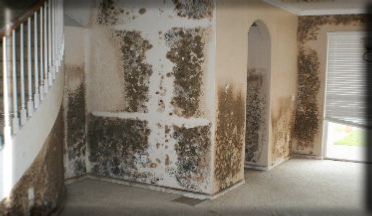
Mold Removal & Water Damage Experts
Serving Broward, Palm Beach, Dade & The Bahamas
Over 25 Years of Experience you can count on!
T
erramar
Restoration
Toll FREE US & CANADA
LOCAL

Excellent References
Competitive Prices, Price Matching
Quality Customer Service
Insurance Billing
Health Effects
The most widely feared mold is Stachybotrys chartarum. This is called stacky, black mold, toxic mold or deadly mold, it’s not the only Toxic mold but the most well known. It’s these type of strains of mold that are associated with health problems in humans.
Much litigation has ensued over mold issues, huge awards have been given to homeowners over nonpayment of mold insurance claims. Additionally, courts have awarded homeowners money for mold damages where they claim the builder was at fault.
Many insurance policies now have clauses that limit the amount they will payout in a mold situation. Some have excluded all mold issues from their policies. The best way to avoid mold problems and litigation is the prevention and control of mold in the first place, before it becomes a problem.
It ‘s well documented that mold contamination in buildings can cause significant
health problems. These problems can include simple allergic responses such as eye,
nose and throat irritation, excessive colds and flu, lowered immune systems, acute
mycotoxicosis (a severe reaction to mold produced toxic chemicals), mold induced
asthma, mold lung infections like aspergillosis, and chronic debilitating lung diseases
such hypersensitivity pneumonitis.
Mold spores can lay dormant for years and when
ideal growing conditions develop, they start to flourish. As summer approaches, the
warm humid conditions are a perfect microenvironment. Bacteria can start to grow
within hours and mold can grow within days. As the days pass by, the odor from hidden
pockets of mold may become more noticeable and in more severe cases the mold growth
may become visible. The greatest risk of adverse health consequences from exposure
to microorganisms can occur during the cleanup process.
The Bible & Mold
The written history of contaminated housing and its health effects can be traced back thousands of years. Leviticus Chapter 13:1-47 and 14:33-47 is one of the oldest known references to ill health effects and contaminated housing.
Some archaeologists believe that individuals referred to as “Lepers” were actually people with fungal infections. The bible speaks of isolation and purification of people with skin diseases, and mold clean up. In biblical times, the priest acted in a similar fashion to today’s home inspector. If mildew was found in the homes, the priest would order the contaminated stones to be torn out, the inside walls to be scraped clean, old stones to be replaced with new ones, and the walls to be replastered. The home was then to be monitored for re-growth. Mold remediation back then was not much different from what is done today.
Further Information can be had at the EPA & CDC On Mold & it’s health affects
Just click symbols
Health effects of Mold
www.terramarrestoration.com
Health and Interesting Mold Related
Occurrences over time
Mold Testing >>
Mold & History
Over the course of time, scientists have found that mold may have been the driving force behind a number of interesting phenomena including stories of leprosy in the Bible, the Salem Witch Trials, the Irish Potato Famine and the curse of the mummy’s tombs.
Recent media coverage leads us to believe that molds are a new problem, but these examples show that molds have played an important part in the course of human history.
Salem Witch Trials & Mold
Mold-induced food poisoning called ergotism may have been responsible for the Salem
Witch Trials of 1692. Ergot, a chemical with effects similar to LSD, is produced
by the fungus Claviceps purpurea, which was believed to have infected the rye crops
of Salem, Massachusetts. It may also have been responsible for the development of
hallucinations, seizures, mental disturbances, miscarriages, and even death in small
children all of which could have been mistaken for witchcraft or satanic influences.
Mold infected crops causing epidemics and mass hysteria can be dated as far back
as the 14th century.
Curse of the Mummy’s Tombs
The tombs of ancient Egypt are famous for their “curses” that call for death and
destruction to those who enter. Many of the explorers who suffered from the supposed
“curse” experienced symptoms similar to those caused by exposure to Aspergillus,
a mold that has been found throughout the Egyptian tombs. Egyptians often buried
food, jewels, and other treasures along with their loved ones for use in the afterlife.
This food may have provided the perfect nutrient source for Aspergillus and other
molds.
The most notorious case of the mummy’s curse occurred with the opening of
King Casimir’s tomb in Poland on April 13, 1973. Within a few days after opening
the tomb, 4 of the 12 researchers present had died. Shortly after, 6 more died. One
of the two remaining survivors was a microbiologist; he suffered equilibrium problems
for 5 years and performed microbiological examinations of the tomb to determine any
correlation between his illness and anything found in the tomb. He found traces of
3 different species of fungi on artifacts that had been removed from the tomb: Aspergillus
flavus, Penicillium rubrum, and Penicillium rugulosum. These fungi produce aflatoxins
B1 and B2 and are speculated to have caused the deaths of the 10 researchers.
It
has also been speculated that these fungi may have been responsible for the death
of Lord Carnarvon, who died a few months after exploring King Tut’s tomb in 1922.
When the mummy of King Tut was examined in 1976, over 370 separate fungal colonies
containing 89 different fungal species (including Aspergillus) were discovered growing
on the mummy. During an analysis of 40 mummies in 1999, a German microbiologist discovered
that each of the mummies contained several potentially dangerous fungal spores. Due
to this evidence, scientists now take extra precautions such as wearing personal
protective equipment when handling mummies and exploring new tombs.
Irish Potato Famine
In 1845, Ireland’s population totaled 8 million people, 4 million of which were enormously dependant on potatoes as a food source for humans and animals alike. A period of rain, which lasted from May 1845 until March 1846 provided textbook conditions for the reproduction of the fungus Phyophthora infestans. This fungus grew on the leaves of potato plants causing entire fields to rot within weeks. Farmers were forced to use their uninfected seed potatoes for food and were therefore unable to plant a new crop the next year. Starvation quickly spread throughout Ireland; three and a half million people died from starvation and disease or were forced to leave the country.

| Sitemap |
| Mold Remediation Procedures |
| Mold How it Grows |
| Common Causes of Mold |
| Health affects of Mold |
| Mold Testing |
| Florida Mold Law |
| Dehumidification |
| Moisture Mapping |
| Disaster Cleanup |
| Art Mold Remediaton |
| Mold Remediation |
| Customer Testimonials |